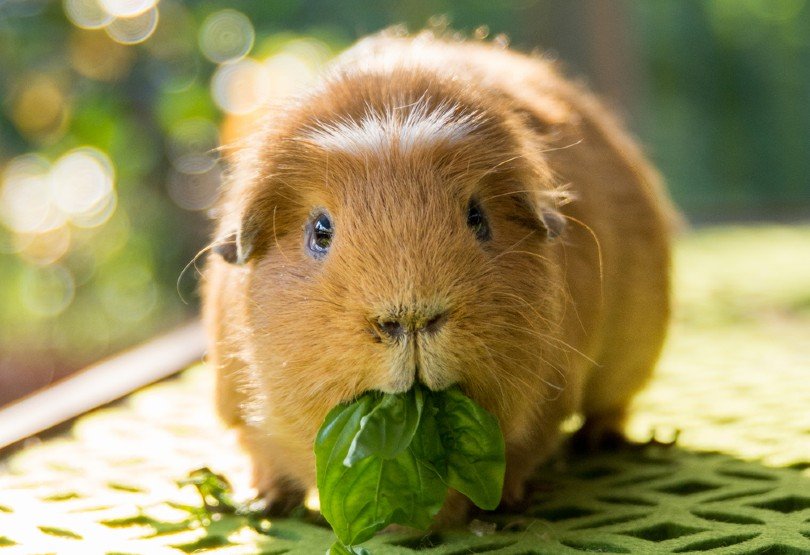Can Guinea Pigs Eat Mustard Greens? Vet-Reviewed Nutrition Facts & FAQ

Updated on

Click to Skip Ahead
If you just added a guinea pig to your family, you may wonder what to feed your new furry, exotic friend to keep him happy and healthy. These adorable little creatures are herbivores, meaning they require plant-based foods, and they require a particular balance of nutrients daily, with the bulk of their diet consisting of Timothy hay. They love leafy greens, and one such green, in particular, that’s safe to feed your piggy is mustard greens, but only in moderation.
In this post, we’ll explain what an appropriate diet is for a guinea pig and what to avoid in order to keep your piggy healthy.
What Are the Benefits of Mustard Greens for Guinea Pigs?
Mustard greens are low in calories and provide a healthy blend of vitamins A, C, E, K, and B6. They also contain calcium, iron, magnesium, and dietary fiber to aid digestion. However, you must feed them raw and not cooked, as cooking them will diminish the nutrients. You’ll need to mix them in with other veggies, and be sure to wash the mustard greens before feeding them to your piggy. Lastly, aim for organic if you can.
While mustard greens are safe to feed your piggy, only feed in moderation due to the high calcium content, roughly once or twice a week—too much calcium can cause your piggy to develop bladder stones. Speaking of calcium, feed Timothy hay and not alfalfa hay—alfalfa hay is high in calcium and can cause problems for your piggy.
Always start slow when introducing mustard greens, or any new food, for that matter, to determine how your piggy will do. A good rule of thumb is to feed 1 tablespoon of any new food, and you can add a little more if your piggy shows no digestive issues.

What Leafy Greens Are Best for Guinea Pigs?
In addition to Timothy hay, Piggies love leafy greens, and they provide nutritional benefits for them. You can provide about 1 cup of leafy greens daily. Here are some of the best leafy greens in addition to mustard greens to offer your piggy.
- Romaine lettuce (avoid Iceberg)
- Basil
- Kale
- Cilantro
- Parsley
- Collard greens
- Dandelions
- Spinach
- Turnip greens

Foods to Avoid Giving Your Guinea Pig
Guinea pigs are herbivores and cannot eat just anything, and there are certain foods you must avoid feeding your piggy altogether due to health hazards and/or toxicity to them and other risks. Let’s take a look.
- Chocolate
- Animal kibble
- Meats (their digestive systems are designed to process only plant-based foods)
- Onions
- Garlic
- Shallots
- Chives
- Leeks
- Dairy
- Avocado
- Mushrooms
- Iceberg lettuce
- Nuts
- Rhubarb
- Seeds of any kind
What Is a Healthy Guinea Pig Diet?
Guinea pigs are herbivorous and require a balanced diet of hay, veggies, and a small amount of fruit. Hay is particularly crucial for your piggy and should make up the bulk of his diet. They need hay to help with digestion and keep their teeth worn down—without hay (and/or grass), your piggy will not survive. Always provide an unlimited amount of Timothy hay daily. You can also provide roughly a tablespoon of commercial pellets daily, but ensure they are fortified with vitamin C. Also, avoid pellets with seeds or added fruits.
Piggies require 1 cup of fresh veggies rich in vitamin C daily. Leafy greens, like the ones mentioned above, are the best choices. It’s okay to feed a variety of veggies each day, such as red or green pepper (avoid the seeds) and broccoli, as they are loaded with vitamin C. Add zucchini, sweet potato, carrots, and tomato once or twice a week for even more variety for your piggy.
Fruits should be limited and cut into small bites. You don’t want to feed too much fruit because fruits are high in sugar. You can provide your piggy with blueberries, apples, bananas, oranges, kiwis, and strawberries in small portions but only once or twice a week due to the sugar content.
Always monitor your piggy to ensure he does not develop diarrhea—if you don’t add new foods gradually, your piggy could suffer an imbalance in the gut.

Conclusion
Mustard greens are perfectly safe to feed your piggy but only in moderation due to their high calcium content. You can provide them once or twice a week, and ensure you mix them with a variety of other veggies. Also, when in doubt, always consult your veterinarian about safe foods to feed your guinea pig.
See also:
- Can Guinea Pigs Eat Peas? Vet-Reviewed Nutrition Facts & FAQ
- Can Guinea Pigs Eat Turnip Greens? Vet-Approved Nutrition Facts
Featured Image Credit: Hans Braxmeier, Pixabay












